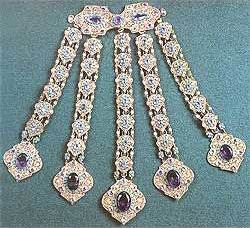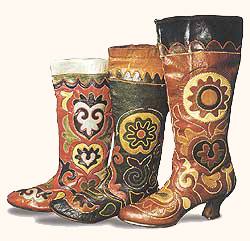Clothes and Trappings
 | |
| Collar's Clasp |
Ancient Turkic clothes in the form of a long tunic-like shirt (kulmek) and loose wide trousers make a basis of the national costume. Woman's shirt was decorated with flounces and frills: a breast bore a special ornament - izu. Tatar outer clothes were open with slim-line back. A sleeveless (or short-sleeved) jacket went atop of a shirt. Woman's jackets were made of velvet, decorated with braid and fur. Bright colors - yellow, green, light-blue, lilac - dominated. The costume was multilayer and heavy altogether due to a set of numerous decorative details. Metal belts with buckles, cast open-work buttons were important elements. Coins also were part of ornamentation, reaching 15-20 in number..
 | |
| Kelepush |
Women and girls braided hair in two plaits, smoothly, with a middle parting. Plaits were decorated with pendants, brushes - chulpy.
 | |
Tatar women traditionally carried a lot of trappings - up to 6 kg - made of silver, turquoise, jasper, coral, amber pieces of work. The Tatar jewelers employed a knobby filigree (known only in Kazan), stamping, molding, engraving, blacking, incrustation.
 | |
They said that because of the tinkling of numerous heavy pendants, rings and earrings, cross-belt hasite, wide bracelets, a Tatar woman was first heard, then seen.
Decorations also played the role of a talisman - thus, turquoise protected from an evil eye, and an equal number of bracelets on each hand helped a married couple to keep love.
The artworks of Tatar craftsmen, gold-embroidery of headgears many times received gold medals in Chicago and Paris, found markets not only in Russia, but also in Asia and Western Europe.
Today the traditional Tatar costume exists in practice of folklore and musical groups. Fashion designers create samples of national costumes for exhibitions and museum expositions.